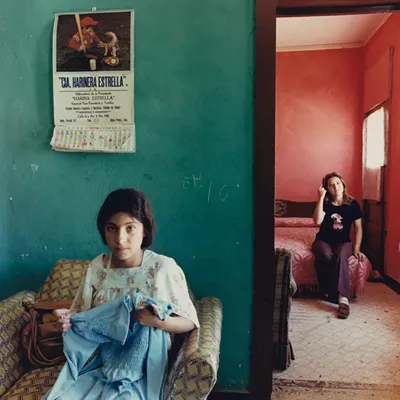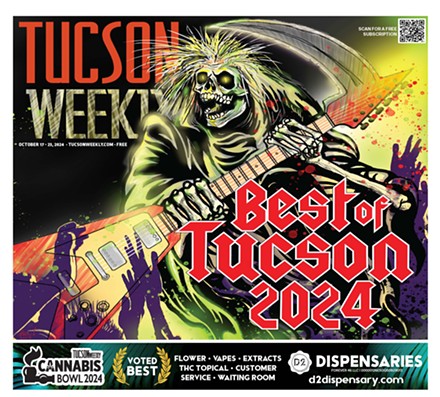For "Chaos Katrina," a 3-D wall piece, he incorporates crude oil, bourbon, gunpowder, 9th Ward debris, Xanax, a South African voodoo snakeskin, reinforced concrete and "African-American sweat and tears." And, oh yes, acrylic paint and resin.
"Zero #1 The New Yorker," a giant painting, contains World Trade Center ash, "brokers' tears," a 1963 Chrysler New Yorker fender insignia, and acrylic paint, charcoal and resin on canvas.
"Arrancar," a dangling javelina sculpture in his 2006 Border Patrol series, is made of a piece of metal from a small crashed airplane, a pottery shard, a girl's bracelet, a St. Mary's emergency-room bandage, low-rider paint, found desert water bottles, Nogales soil, Latino sweat and tears and "deceased Mexican-American human ash."
In fact, the lists are so long--and so fascinating--that you run the risk of reading instead of looking. Plus, the art, hanging above tables and in corners and along the staircase at Espresso Art coffeehouse just west of the UA, is hard to see. To look at it, you have to make a nuisance of yourself, peering above coffee drinkers' heads. And that's too bad, because Bernstein's work is extravagant and untamed, and more than a little anguished.
He swears that he's not exaggerating about the blood, sweat, tears and human ash.
"People bring me a lot of things," he says by phone. "I seek people out."
His subjects are contemporary holocausts and their dead--the blown up of Sept. 11, the drowned of Katrina, the dehydrated and desiccated of our own Arizona desert. (In the past, he's made work about the Holocaust with a capital H.) Bernstein's M.O. is to go to the scenes of the crimes and bring back objects that have some bearing on the lives of those who have perished. Then he incorporates these mementos mori into his own skillfully composed drawings and paintings.
In "Bullit Smokes the Bulldozers," a 10-foot-long Katrina painting finished in 2006, he retrieved found photos of former residents of the submerged 9th Ward, and placed these real-life images into his own painted cars. A black high school boy in a blue graduation cap and gown grins in the passenger seat of a sporty green car on the left side of the giant diptych; a small boy smiles in the window of an orange car on the right. Bernstein lists the images of the two boys as "photos of those lost."
Real Mardi Gras beads line the grills and hubcaps of both cars, and a tin house number, 815, long since washed away from its usual place on somebody's front porch, floats poignantly in the sky. A couple of vinyl records drift along as well, surrounded by the kind of festive party feathers people associate with New Orleans. Lessening the impact somewhat is the news that Bernstein picked up the records right here in Tucson, at a MOCA installation by Jessica James Lansdon that invited visitors to take away her found objects.
Bernstein is good at drawing cars--the two sporty models seem ready to zoom right out of the painting--but it's unclear why he uses them, several times over, as motifs in his Katrina works. After all, one reason people were trapped in the African-American 9th Ward is that they were too poor to own the cars that would have allowed them to escape before the storm hit. Perhaps Bernstein's imaginary cars are mostly wishful thinking. If the people in his art would have had his painted cars, they could have escaped along with the rest of New Orleans.
A lively charcoal drawing revs up the Sept. 11 piece "Zero #1 The New Yorker." The World Trade Center towers teeter at the center of the 6-foot-long work, while big bold lines radiate out in circles from the doomed buildings. The lines suggest, all at once, a target, plane propellers and an explosion. Hovering above the chaos are the words "New Yorker" in a cheery metallic script; it's a 3-D title lifted from the fender of an old Chrysler car.
Bernstein paints in between his charcoal lines, using surprisingly gentle tones of pale pink, green and yellow. The technique, mixing paint and dusty charcoal in one work, makes a good match for his subject. When all hell is breaking loose, why bother with tidy art rules?
This big show features a couple dozen works, mostly about Katrina, but recently, the artist has begun to turn his attention to the holocaust that takes place around Tucson every summer. The deadly season for migrants has already begun.
Just a few pieces from the new Border Patrol series are on display. "Wonderhorse" pairs a child's rocking horse with an antique farming plow that's been embedded in the plastic body to look like wings. A real steer skull replaces the hobby horse's head. And the materials list announces that the piece also contains "Mexican immigrant ash."
The sculpture "Arrancar" is a golden flying javelina that's been pierced by hunters' arrows. Its body is wrapped in bandages, and water bottles that could have saved somebody's life are embedded at the end of the wings. Flight seems to be the emerging theme of the series.
These new pieces do not yet have the grief-stricken power of the Katrina works, but give Bernstein time. The more he immerses himself in the continuing desert tragedy, the more opportunity he'll have to howl his rage.










